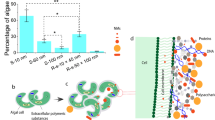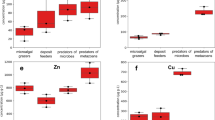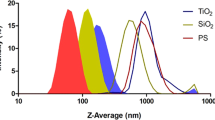Abstract
Within the next five years the manufacture of large quantities of nanomaterials may lead to unintended contamination of terrestrial and aquatic ecosystems1. The unique physical, chemical and electronic properties of nanomaterials allow new modes of interaction with environmental systems that can have unexpected impacts2,3. Here, we show that gold nanorods can readily pass from the water column to the marine food web in three laboratory-constructed estuarine mesocosms containing sea water, sediment, sea grass, microbes, biofilms, snails, clams, shrimp and fish. A single dose of gold nanorods (65 nm length × 15 nm diameter) was added to each mesocosm and their distribution in the aqueous and sediment phases monitored over 12 days. Nanorods partitioned between biofilms, sediments, plants, animals and sea water with a recovery of 84.4%. Clams and biofilms accumulated the most nanoparticles on a per mass basis, suggesting that gold nanorods can readily pass from the water column to the marine food web.
This is a preview of subscription content, access via your institution
Access options
Subscribe to this journal
Receive 12 print issues and online access
$259.00 per year
only $21.58 per issue
Buy this article
- Purchase on Springer Link
- Instant access to full article PDF
Prices may be subject to local taxes which are calculated during checkout


Similar content being viewed by others
References
Handy, R. D., Owen, R. & Valsami-Jones, E. The ecotoxicology of nanoparticles and nanomaterials: current status, knowledge gaps, challenges and future needs. Ecotoxicology 17, 315–325 (2008).
Behra, R. & Krug, H. Nanoecotoxicology—Nanoparticles at large. Nature Nanotech. 3, 253–254 (2008).
Owen, R. & Handy, R. Formulating the problems for environmental risk assessment of nanomaterials. Environ. Sci. Technol. 41, 5582–5588 (2007).
Xie, B., Xu, Z. H., Guo, W. H. & Li, Q. L. Impact of natural organic matter on the physicochemical properties of aqueous C-60 nanoparticles. Environ. Sci. Technol. 42, 2853–2859 (2008).
Hyung, H., Fortner, J. D., Hughes, J. B. & Kim, J. H. Natural organic matter stabilizes carbon nanotubes in the aqueous phase. Environ. Sci. Technol. 41, 179–184 (2007).
Manning, A. J., Bass, S. J. & Dyer, K. R. Floc properties in the turbidity maximum of a mesotidal estuary during neap and spring tidal conditions. Mar. Geol. 235, 193–211 (2006).
Lauth, J. R., Scott, I. G., Cherry, D. S. & Buikema, A. L. A modular estuarine mesocosm. Environ. Toxicol. Chem. 15, 630–637 (1996).
Walse, S. S., Scott, G. I. & Ferry, J. L. Stereoselective degradation of aqueous endosulfan in modular estuarine mesocosms: formation of endosulfan gamma-hydroxycarboxylate. J. Environ. Monitor. 5, 373–379 (2003).
Walse, S. S., Pennington, P. L., Scott, G. I. & Ferry, J. L. The fate of fipronil in modular estuarine mesocosms. J. Environ. Monitor. 6, 58–64 (2004).
Bejarano, A. C., Pennintong, P. L., DeLorenzo, M. E. & Chandler, G. T. Atrazine effects on meiobenthic assemblages of a modular estuarine mesocosm. Mar. Pollut. Bull. 50, 1398–1404 (2005).
Pennington, P. L. et al. The design, construction, operation and maintenance of the replicated modular estuarine mesocosm. NOAA Technical Memorandum NOS NCCOS, 62, 77 (2007).
Murphy, C. J., Gole, A. M., Hunyadi, S. E. & Orendorf, C. J. One dimensional colloidal gold and silver nanostructures. Inorg. Chem. 45, 7544–7554 (2006).
Sau, T. K., Murphy, C. J. & Murphy, J. Seeded high yield synthesis of short Au nanorods in aqueous solution. Langmuir 20, 6414–6420 (2004).
Krauskopf, K. B. The solubility of gold. Econ. Geol. 46, 858–870 (1951).
Falkner, K. K. & Edmond, J. M. Gold in seawater. Earth Planet. Sci. Lett. 98, 208–221 (1990).
Decho, A. W. Microbial exopolymer secretions in ocean environments: their role(s) in food webs and marine processes. Oceanogr. Mar. Biol. Ann. Rev. 28, 73–153 (1990).
Zhu, H., Han, J., Xiao, J. Q. & Jin, Y. Uptake, translocation and accumulation of manufactured iron oxide nanoparticles by pumpkin plants. J. Environ. Monitor. 10, 713–717 (2008).
Navarro, E. et al. Environmental behavior and ecotoxicity of engineered nanoparticles to algae, plants and fungi. Ecotoxicology 17, 372–386 (2008).
Chithrani, B. D., Ghazani, A. A. & Chan, W. C. W. Determining the size and shape dependence of gold nanoparticle uptake into mammalian cells. Nano Lett. 6, 622–628 (2006).
Connor, E. E., Mwamuka, J., Gole, A., Murphy, C. J. & Wyatt, M. D. Gold nanoparticles are taken up by human cells but do not cause acute cytotoxicity. Small 1, 325–327 (2005).
Hauck, T. S., Ghazani, A. A. & Chan, W. C. W. Assessing the effect of surface chemistry on gold nanorod uptake, toxicity and gene expression in mammalian cells. Small 4, 153–159 (2008).
Lewinski, N., Colvin, V. & Drezek, R. Cytotoxicity of nanoparticles. Small 4, 26–49 (2008).
Robichaud, C. O., Tanzil, D., Weilenmann, U. & Wiesner, M. R. Relative risk analysis of several manufactured nanomaterials: an insurance industry context. Environ. Sci. Technol. 39, 8985–8994 (2005).
Pennington, P. L. The replicated modular estuarine mesocosm: assessing direct and indirect effects of pesticide exposure, in Environmental Health Sciences 249 (Univ. South Carolina, 2002).
Price, T. J., Thayer, G. W., LaCroix, M. W. & Montgomery, G. P. Proceedings of the National Shellfisheries Association, in Annual Meeting of the National Shellfisheries Association (Waverly Press, 1976).
Roesijadi, G., Anderson, J. W. & Giam, C. S. Osmoregulation of the grass shrimp Palaemonetes pugio exposed to polychlorinated biphenyls (PCBs) II. Effect on free amino acids of muscle tissue. Mar. Biol. 38, 357–363 (1976).
Underwood, J. C., Phillips, J. & Saunders, K. Distribution of estuarine benthic diatom species along salinity and nutrient gradients. Eur. J. Phycol. 33, 173–183 (1998).
Nordlie, F. G., Wahl, W. A., Binello, J. & Haney, D. C. Body water content over a range of ambient salinities in the sheepshead minnow. J. Fish Biol. 47, 624–630 (2005).
Wang, J. et al. Exotic Spartina alterniflora provides compatible habitats for native estuarine crab Sesarma dehaani in the Yangtze River estuary. Ecol. Eng. 34, 57–64 (2008).
Acknowledgements
This work was supported by the University of South Carolina Nanocenter.
Author information
Authors and Affiliations
Contributions
J.L.F., T.J.S., P.L.P. and M.H.F. conceived and designed the experiment. P.S. and C.J.M. synthesized the nanoparticles. P.C., R.F. and P.L.P. dosed and sampled from the mesocosms. I.G.S., M.H.F. and P.L.P. maintained the mesocosms. C.H., P.C. and T.J.S. digested the samples and performed the ICP-MS analyses. A.W.D. provided biofilm sampling apparatus and procedures. S.K. performed Cyprinodon dissections. J.L.F., C.J.M. and T.J.S. wrote the manuscript. All authors contributed to materials and analysis tools, discussed the results and contributed to the manuscript.
Corresponding author
Supplementary information
Supplementary information
Supplementary information (PDF 1313 kb)
Rights and permissions
About this article
Cite this article
Ferry, J., Craig, P., Hexel, C. et al. Transfer of gold nanoparticles from the water column to the estuarine food web. Nature Nanotech 4, 441–444 (2009). https://doi.org/10.1038/nnano.2009.157
Received:
Accepted:
Published:
Issue Date:
DOI: https://doi.org/10.1038/nnano.2009.157
This article is cited by
-
The Toxic Effects of Cu and CuO Nanoparticles on Euplotes aediculatus
Microbial Ecology (2023)
-
Critical Review of Engineered Nanoparticles: Environmental Concentrations and Toxicity
Current Pollution Reports (2022)
-
Bioaccumulation assessment of nanomaterials using freshwater invertebrate species
Environmental Sciences Europe (2021)
-
Particle number-based trophic transfer of gold nanomaterials in an aquatic food chain
Nature Communications (2021)
-
Toxicity of gold nanorods on Ceriodaphnia dubia and Danio rerio after sub-lethal exposure and recovery
Environmental Science and Pollution Research (2021)



